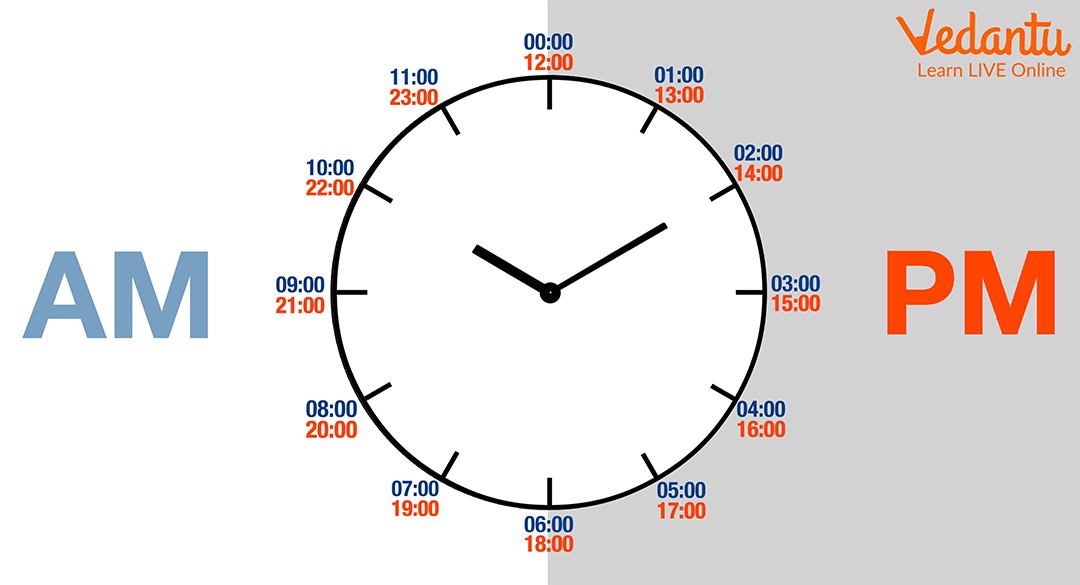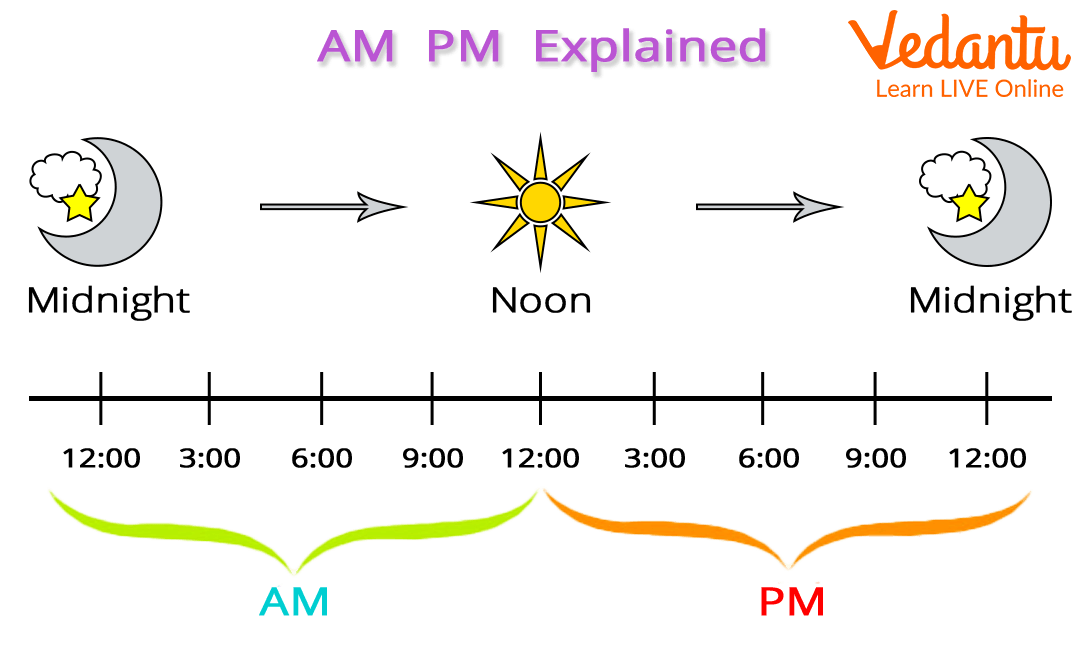




How to Identify PM Hours: Easy Guide with Solved Problems
Every morning, mom must be waking you up at 6 or 7. You might be going to school at 8 and coming back at 4. Have you ever noticed that the we get same time twice a day. For example - 6 in the morning and 6 in the evening. If you have to tell someone about something you did the last evening 7, how would you make them understand that you are talking about evening 7 and not morning 7? To mitigate this confusion, we have “AM” and “PM” to describe time. If you want to tell the morning time, you use “AM” and if you want to tell the evening time, you use “PM”. Let’s understand this in detail.
PM stands for ‘post meridiem’, a Latin word that means ‘after noon’. It is the period that lasts from noon to midnight. PM is the time after the sun has crossed the meridian line. PM, i.e., post meridiem, is also abbreviated as P.M. or pm or p.m.

AM-PM Clock System
Clock System
Clock systems are used to reference the time. To identify the 24 hours of a day, we use two types of clock systems. These are:
24-hour clock system
12-hour clock system or AM-PM clock system
In the 24-hour clock system, a day lasts from midnight to midnight and is divided into 24 hours. Whilst the 12-hour clock system has two intervals of 12 hours each, from midnight to noon (midday), and noon to midnight. A 12-hour clock system is most commonly used in electronic gadgets, e.g., computers, laptops, digital watches, etc.
The interval between midnight to noon is known as AM, whereas the interval between noon to midnight is known as PM.
Where to Use PM?
Sometimes, we get confused with the AM-PM usage, as in where to use a.m. and p.m. exactly. To make it simple and easy to understand, you need to look over the below-given image.

How to use the AM-PM Clock System?
Suppose you are going for a morning walk, then the timings will be 5 AM to 6 AM or 7 AM to 8 AM. (Hey, you are supposed to wake up early in the morning!) So, AM includes the timings when the sun starts rising and till it comes to its peak point.
And, the PM period includes the time when the sun begins to set and hides completely. For example, if you are going for an evening walk, then the timings would be 5 PM or 6 PM. (No return timing until or unless your mother yelled out to you!)
Midnight 12 and Noon 12: AM or PM?
What exactly is 12 noon or 12 midnight called? Well, it is still not answered by the scientists yet. To avoid confusion, they recommend using the words ‘noon’ and ‘midnight’ followed by the number 12 or to opt for a 24-hour clock system.
So, when it is 12:00:00, we need to look out of our room and if it is dark, it would be 12 midnight, or in case of light, it would be 12 noon.
Converting PM to 24-hour Clock System
The 12-hour clock system and 24-hour clock system are interchangeable with each other. To convert PM to 24-hour clock format, add 12 hours.
For example, if you had lunch at 2:00 pm, then in the 24-hour clock format, it would be (2:00 + 12) = 14:00 hours.
In the below table, find some more examples converting PM to 24-hour format.
Converting 24-hour Clock System to PM
The 12-hour clock system is more often used by civilians or non-scientific people. To convert 24-hour clock format to PM, subtract 12 hours.
For example, if your friend is inviting you to play with him at 17:00 hours. Do not get stuck! Subtract 12 hours, i.e., (17:00 – 12:00)= 5:00 p.m. So, you can go to your friend's home to play at exactly 5:00 p.m.
In the below table find some more examples converting the 24-hour format to PM.
Do You Know?
The first known use of post meridiem (p.m.) was in 1647.
The 24-hour clock system is also known as military time in the United States.
To convert AM to the 24-hour clock system or vice-versa, some addition or subtraction is required.
Tip for Parents
We request all parents to have some AM-PM activities with their kids. You can make a chart of their daily activities and ask them to fill in the timing with respect to the AM-PM clock system. Also, you can ask them to fill the respective 24-hours timings.
Solved Numerical Problems
1. Convert 20:00 hours to a 12-hour clock system.
Ans. To convert a 24-hour system to a 12-hour clock system, subtract the given time by 12 hours.
Therefore, 20:00 – 12 = 8:00 p.m.
2. Convert 11:55 p.m. to 24-hour clock system.
Ans. To convert p.m. time to 24-hour format, we add 12 hours.
Therefore, 11:55 p.m. + 12 = 23:55 hours.
Conclusion
In this article, we have learnt basic concepts related to post meridian (p.m.). We get the idea of using different clock formats along with their definitions. We also find the answer about the midday and midnight conventions. Also, we learnt to convert a 24-hours clock to PM and vice-versa.
FAQs on What Is Post Meridiem (PM) in Time?
1. What is AM and PM?
AM and PM are the time conventions of the 12-hour clock system. The AM period starts from midnight and ends at noon whereas the PM period starts at noon and ends at midnight.
2. What is the difference between a 12-hour clock system and 24-hour clock system?
In the 12-hour clock system, a day is divided into two periods of 12 hours each, whereas in the 24-hour clock system, no division is required. The 12-hour clock system is also known as the AM-PM clock system.

















